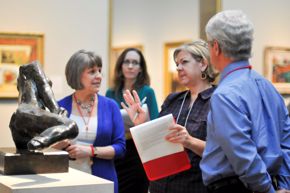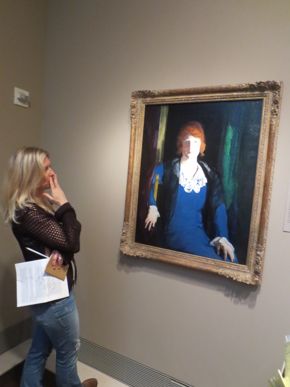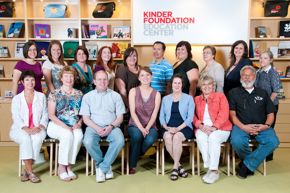About “Learning Through Art for Middle School Educators”
Learning Through Art for Middle School Educators (LTA/MS) is an exploration of how a work of art contributes to a student's understanding of both the sciences and the humanities. The LTA/MS curriculum links together principles from different disciplines through the art collections of the Museum of Fine Arts, Houston. The focus is not on how art can illustrate the concepts of other disciplines. Instead, LTA/MS asks: How can investigating works of art affect habits of mind, metacognition, and how—rather than what—a student learns?
► Read about the Learning Through Art research initiative
► Read the Learning Through Art Executive Summary and Evaluation
► Watch videos to explore Learning Through Art curriculum
Learning Through Art for Middle School Educators is based on the following principles:
- Art is the center to learning across disciplines by developing habits of mind. The ability of the Museum's art collections to make transparent the interconnectedness of diverse curricula lies in specific practices that are central to responding to art. These practices include exploring diverse perspectives, understanding visual-spatial relationships, reasoning and evaluation, and informed risk taking.
- The development of habits of mind promotes a learning environment that prepares students for today’s global society. Object-based learning encourages reflection, self-expression, and the willingness to experiment and learn from one’s mistakes. Achieving success in today’s information-based, entrepreneurial society demands certain skills that are not often assessed by standardized tests and, therefore, are not necessarily taught through regular curriculum.
- The Museum and schools must form true partnerships, founded on the exchange of ideas and expertise that positions the Museum—and therefore art—as a partner in the education of teachers and students. To do so, Museum educators must have knowledge of the school curriculum and the needs of students, and classroom teachers must develop their object-based teaching skills and learn about the Museum’s art collections.
- Students are motivated by experiential learning activities and learn best by actively engaging in inquiry and object-based learning. This approach allows for the application of knowledge in a real-world setting. Research confirms that it results in a deeper understanding of content and the ability to make sense of complex ideas.
Habits of Mind
Habits of mind are thinking dispositions that encompass skills, attitudes, and past experiences that develop reflective, intellectual pursuits. This type of critical thinking relies on developing close observation skills, strengthening problem solving, and making informed interpretations. To be successful in today’s global society, students must become flexible problem solvers with the propensity to fail intelligently. Discussion through works of art encourages effective ways to approach ambiguous and complex ideas, thoughts, and feelings. The Museum offers a democratic space where students and teachers can develop, practice, and articulate these habits of mind.
Additionally, habits of mind are the connections between the classroom and the Museum. Through the research, the LTA/MS project team selected six distinctive groupings of similar habits as the key skills in becoming successful in the classroom and beyond. MFAH artworks take the central role in the process of developing these habits through carefully constructed investigations and conversation, resulting in direct and tangible connections to the classroom curriculum.
Research Initiative
In 2011, the Museum received a grant to research, develop, and test interdisciplinary curriculum lesson plans for Learning Through Art for Middle School Educators. This project resulted in an online curriculum and a series of professional-development workshops, as well as new research that examines middle school educators’ practice, attitudes, and perceptions of art and museums, and the use of art in the classroom. The goal of this collaboration was to create a bold approach to middle school curriculum that aligns the arts with language arts, math, science, and social studies, with an emphasis on revealing and strengthening habits of mind that lead to success in the classroom and beyond.
As a result, the project team in the Museum's department of learning and interpretation organized a group of teachers from across the Houston area. The group represents public, private, and parochial schools; teaches grades ranging from fifth to eighth; and includes the disciplines of art, language arts, math, science, and social studies. The Kinder Foundation Education Center teacher fellows collaborated with the MFAH project team to help to determine the framework of the curriculum and to advise on the needs of classroom teachers and middle school students.
The Learning Through Art program is endowed by Melvyn and Cyvia Wolff.
The Learning Through Art curriculum website is made possible in part by a grant from the Institute of Museum and Library Services.
All Learning and Interpretation programs at the Museum of Fine Arts, Houston, receive endowment income from funds provided by the Louise Jarrett Moran Bequest; Caroline Wiess Law; the William Randolph Hearst Foundation; The National Endowment for the Humanities; the Fondren Foundation; BMC Software, Inc.; the Wallace Foundation; the Neal Myers and Ken Black Children’s Art Fund; the Favrot Fund; and Gifts in honor of Beth Schneider.



